Ginger Dehlinger's Blog, page 6
May 6, 2019
Sea Glass Published by Spank the Carp
Following on the heels of National Poetry Month, one of my poems was published May 1 in issue number 50 of the online magazine Spank the Carp. I was especially pleased by the message I received from editor Ken S when he informed me some time back my poem had been chosen.
Congratulations, I've decided to accept your work 'Sea Glass' for publication in SPANK the CARP.-- Ginger: What a great "total" poem, in that everything about it works toward a single purpose. I loved the ebb and flow depicted in the shape of the stanzas. And the sounds too were well chosen. - Ken
Sea Glass
A tiny jewel rolls in with the tide.Before the briny pulls it backI add it to the kaleidoscope cradled in my hand algae greens whites frothy as foam seaweed brownsand one oh-so-rare cerulean blue.
Surf pounds, sunlight dances water trickles through my toes while I pause to reflect on how long it took rocks and reef salt and sand wind and waves to smooth and gently etch these crystal gems.
Each fragment harbors the tale of a vessel and what it might have stowedbefore Poseidon’s fork broke it apart a lover’s note Coco’s perfume Jim Croce’s time or plain ol’ backyard beer.
‘Twas the journey that glorified this glass not purpose, nor the one who held it last. I will wrap these gems in silver and wear them in my hair ‘round my neck on my toes as treasure discovered on faraway shores. Ginger Dehlinger
Congratulations, I've decided to accept your work 'Sea Glass' for publication in SPANK the CARP.-- Ginger: What a great "total" poem, in that everything about it works toward a single purpose. I loved the ebb and flow depicted in the shape of the stanzas. And the sounds too were well chosen. - Ken
Sea Glass
A tiny jewel rolls in with the tide.Before the briny pulls it backI add it to the kaleidoscope cradled in my hand algae greens whites frothy as foam seaweed brownsand one oh-so-rare cerulean blue.
Surf pounds, sunlight dances water trickles through my toes while I pause to reflect on how long it took rocks and reef salt and sand wind and waves to smooth and gently etch these crystal gems.
Each fragment harbors the tale of a vessel and what it might have stowedbefore Poseidon’s fork broke it apart a lover’s note Coco’s perfume Jim Croce’s time or plain ol’ backyard beer.
‘Twas the journey that glorified this glass not purpose, nor the one who held it last. I will wrap these gems in silver and wear them in my hair ‘round my neck on my toes as treasure discovered on faraway shores. Ginger Dehlinger
Published on May 06, 2019 14:11
April 6, 2019
April is National Poetry Month
When I retired and began writing for fun and the profit that never materialized, my focus was prose. I spent close to ten years writing and promoting my novels "Brute Heart" and "Never Done." I also wrote a few essays and short stories.
Then, inspired by two poets in my critique group, I started playing around with poetry. I learned rhyming poetry was passe, that today's readers prefer blank verse or free verse. Unfortunately, most of my early attempts at writing poetry consisted of lines that rhymed. Sometimes the rhymes showed up even when I made a conscious effort to avoid them.
For the last year or so I have been submitting my work to online magazines, and surprise, surprise, 5 of my poems have been published. Who'd a thunk it? One of the poems even rhymed.
Since April is National Poetry Month I decided to post a poem that is appropriate for both the month and the changeable weather in Oregon's high desert. This poem (free verse) has not been accepted for publication. Nature poems have to be super special to interest most editors, plus what you see below is probably too short.
April Snow
Flecks of crystaldust my windshield dance on the hoodscurry across the asphalt—tiny white beadsthat never seem to land.
Where are the robins?
Five miles south of here a ripe orange sun brought tears to my eyes.
Ginger Dehlinger
Then, inspired by two poets in my critique group, I started playing around with poetry. I learned rhyming poetry was passe, that today's readers prefer blank verse or free verse. Unfortunately, most of my early attempts at writing poetry consisted of lines that rhymed. Sometimes the rhymes showed up even when I made a conscious effort to avoid them.
For the last year or so I have been submitting my work to online magazines, and surprise, surprise, 5 of my poems have been published. Who'd a thunk it? One of the poems even rhymed.
Since April is National Poetry Month I decided to post a poem that is appropriate for both the month and the changeable weather in Oregon's high desert. This poem (free verse) has not been accepted for publication. Nature poems have to be super special to interest most editors, plus what you see below is probably too short.
April Snow
Flecks of crystaldust my windshield dance on the hoodscurry across the asphalt—tiny white beadsthat never seem to land.
Where are the robins?
Five miles south of here a ripe orange sun brought tears to my eyes.
Ginger Dehlinger
Published on April 06, 2019 08:32
March 8, 2019
Fun With Grammar
After posting several months about the days of the week housewives traditionally did specific chores, I decided it was time for lighter fare. Below are some humorous takes on a few weird aspects of English grammar.










Published on March 08, 2019 15:36
February 7, 2019
No Rest
I chose the name "No Rest" for Part VII of Never Done as a way to reinforce the message inherent in the novel's title. I also favored "No Rest" for the seventh day of the week because the Bible asks Christians to treat Sunday as a day of rest. Even today, with many labor-saving devices in their homes, women rarely just go to church and read the Bible on the sabbath.
In Part VII, not only is Clara running a hotel in Montrose, Colorado, she has to deal with the flu epidemic of 1918. My great-grandmother wrote about the deadly disease and how it affected her and her family in seven paragraphs of an autobiography that was 148 hand-written pages long.
When writing Never Done I expanded those seven paragraphs into 23 pages. Below are a couple of passages from the novel. In the first excerpt I share a bit of what I came across during my research.
As the disease spread, chatter filled the phone lines, some people claiming the disease was a secret
weapon unleashed by the Germans. Children began jumping rope to a new ditty.
I had a little bird,It’s name was Enza.I opened the window,And in-flu-enza.
The 1918 flu was especially hard on the people of Colorado, and in this second excerpt Clara tries to reassure her daughter and calm her nerves.
“Nobody is going to die here,” Clara said without raising her voice. “After they rest for a few days, they’ll be fine. I can’t throw people out. Where would they go? Every hospital in the state is full, and no one is going to take them into their homes.”
“This is a plague, Mother, a plague! Shops are padlocked. Theaters closed. The streets are nearly
empty.”
Clara smoothed Pearl’s dark brown hair off her brow. “Don’t be so dramatic, Baby. People don’t
survive a plague. The trains are still running. So is the stage.”
If you'd like to read more about this disease known as the Spanish flu, scroll back to my post from November 9th. As you'll see, I was so fascinated with what I learned in my research I had to write more about it.
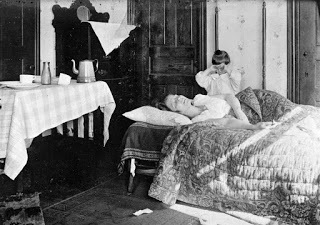
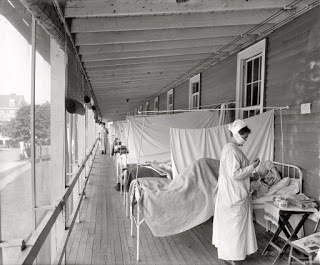
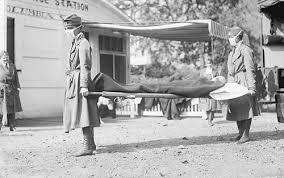
In Part VII, not only is Clara running a hotel in Montrose, Colorado, she has to deal with the flu epidemic of 1918. My great-grandmother wrote about the deadly disease and how it affected her and her family in seven paragraphs of an autobiography that was 148 hand-written pages long.
When writing Never Done I expanded those seven paragraphs into 23 pages. Below are a couple of passages from the novel. In the first excerpt I share a bit of what I came across during my research.
As the disease spread, chatter filled the phone lines, some people claiming the disease was a secret
weapon unleashed by the Germans. Children began jumping rope to a new ditty.
I had a little bird,It’s name was Enza.I opened the window,And in-flu-enza.
The 1918 flu was especially hard on the people of Colorado, and in this second excerpt Clara tries to reassure her daughter and calm her nerves.
“Nobody is going to die here,” Clara said without raising her voice. “After they rest for a few days, they’ll be fine. I can’t throw people out. Where would they go? Every hospital in the state is full, and no one is going to take them into their homes.”
“This is a plague, Mother, a plague! Shops are padlocked. Theaters closed. The streets are nearly
empty.”
Clara smoothed Pearl’s dark brown hair off her brow. “Don’t be so dramatic, Baby. People don’t
survive a plague. The trains are still running. So is the stage.”
If you'd like to read more about this disease known as the Spanish flu, scroll back to my post from November 9th. As you'll see, I was so fascinated with what I learned in my research I had to write more about it.



Published on February 07, 2019 14:38
January 5, 2019
Live, Love, Bake
The C. A. Pillsbury Company was founded in 1872, the year after Clara, the protagonist in Never Done, was born. In Part VI of the novel Clara spends the better part of every Saturday baking bread, pies, or other desserts, and probably, though not mentioned by name, out of Pillsbury flour.
After cleaning house on Friday, Clara and most nineteenth/early twentieth century housewives devoted Saturday to the week's baking. Sugared baked goods kept better than homemade bread, but by baking bread on Saturday she could serve it almost fresh with Sunday dinner.
Air is bread's enemy. A breadbox kept it fresh a little longer
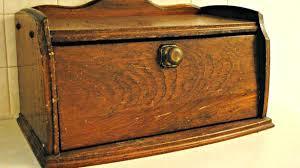
Part VI begins on a Saturday. "With the aroma of baking bread filling every corner of the hotel, Clara celebrated her first year as manager in the kitchen. It was a cool September afternoon, but the sunshine spilling through the windows, combined with the heat from the oven, made the kitchen almost unbearable. Using the hem of her apron, she blotted perspiration from her upper lip. Then she folded a pat of dough in half, kneaded it with the heels of her hands, and folded it again, pushing and punching, dusting it with flour until the dough reached the texture of an earlobe."

Clara had many bread-making failures before learning how to compensate for the higher altitudes of Western Colorado's mountains: "dough that wouldn’t rise, yeast that died, bread with so many holes in it there wasn’t any place to spread the butter."
She had no trouble baking pies, though, even in the mining town of Ophir Loop. Below is her pie dough recipe.
2 c. flour
3/4 c. lard
a salt spoon of salt
6 tbsp. of cold water
I modeled Clara after my great-grandmother Ella Tripler Leaming Fell, an excellent bread and pie baker who died in 1959. Grandma Fell lived long enough to witness the first Pillsbury Bake-off in 1949 and the packaged biscuit dough that began appearing in grocery stores in the early 50's. She never met the Pillsbury Doughboy born in 1965. I think she would have liked him.
After cleaning house on Friday, Clara and most nineteenth/early twentieth century housewives devoted Saturday to the week's baking. Sugared baked goods kept better than homemade bread, but by baking bread on Saturday she could serve it almost fresh with Sunday dinner.
Air is bread's enemy. A breadbox kept it fresh a little longer

Part VI begins on a Saturday. "With the aroma of baking bread filling every corner of the hotel, Clara celebrated her first year as manager in the kitchen. It was a cool September afternoon, but the sunshine spilling through the windows, combined with the heat from the oven, made the kitchen almost unbearable. Using the hem of her apron, she blotted perspiration from her upper lip. Then she folded a pat of dough in half, kneaded it with the heels of her hands, and folded it again, pushing and punching, dusting it with flour until the dough reached the texture of an earlobe."

Clara had many bread-making failures before learning how to compensate for the higher altitudes of Western Colorado's mountains: "dough that wouldn’t rise, yeast that died, bread with so many holes in it there wasn’t any place to spread the butter."
She had no trouble baking pies, though, even in the mining town of Ophir Loop. Below is her pie dough recipe.
2 c. flour
3/4 c. lard
a salt spoon of salt
6 tbsp. of cold water
I modeled Clara after my great-grandmother Ella Tripler Leaming Fell, an excellent bread and pie baker who died in 1959. Grandma Fell lived long enough to witness the first Pillsbury Bake-off in 1949 and the packaged biscuit dough that began appearing in grocery stores in the early 50's. She never met the Pillsbury Doughboy born in 1965. I think she would have liked him.
Published on January 05, 2019 15:10
December 17, 2018
Christmas 2018
Rather than impose my annual Christmas letter on friends and family, I decided to post it here to read when they have time and only if interested.
Published on December 17, 2018 11:54
December 8, 2018
New Brooms Sweep Clean
Prior to the invention of labor-saving devices that make it possible to clean floors, bathrooms, etc. on an as-needed basis, the average American housewife spent most of every Friday cleaning her home. There was a certain logic to this. With her house clean by Friday afternoon she was ready to welcome weekend guests or invite the pastor and his wife to Sunday dinner.
Brooms were primitive, sometimes hand-made out of broomcorn (a variety of sorghum), straw, or the thinnest branches of a birch tree.
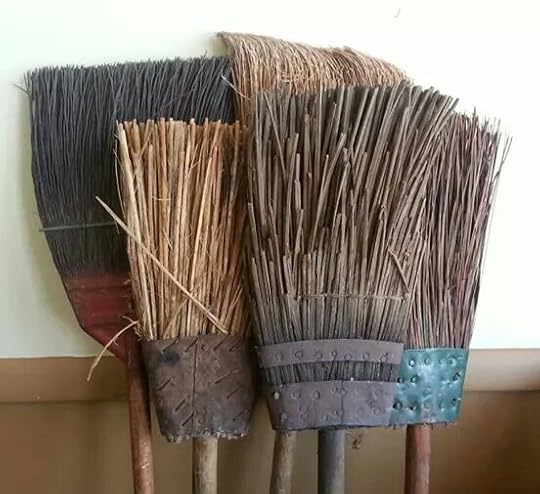
Cleaning a privy was an especially odious task. In Part V of Never Done I wrote:
Clara helped Sophie clean the two privies. This entailed sweeping them out, scrubbing around the two holes in each latrine, and replenishing the paper supply with whatever they could find: catalogs, nickel weeklies, calendars, almanacs, newspapers, even dog-eared dime novels. Finished up top, Clara tossed a cupful of lye powder down the holes.
“Smell better now, Missus,” Sophie would say, even when it didn’t.
Since most houses were heated by wood and lit by coal oil or kerosene lamps, layers of sooty grime built up over time, especially during winter months. Spring cleaning, now a ritual of the past, was imperative.
The plip, plip, plip of melting icicles signaled the beginning of what amounted to spring in Ophir Loop.
Inside the hotel, months of exposure to wood heat and coal oil lamps had left a greasy film on everything. Windows were thrown open and rugs and coverlets taken outside for a good beating. Curtains were washed, floors scrubbed, quilts boiled and stretched across tree stumps to dry. Every pillow and mattress was emptied, the ticking bleached, boiled, dried, and filled with clean hay or sheep shearing. The cans, cartons, baskets, and barrels that filled the cellar were shifted from one corner to another while the shelves were wiped down with vinegar water.
Vinegar water was also used to scrub floors, and scrubbing a floor wasn't a simple task when water wan't piped into the house. Most housewives had to haul water from a well or nearby stream in order to fill their wash pails. Mops were fashioned from heavy cord or strips of fabric torn from discarded sheets or clothing. One of the first labor-saving devices welcomed by the American housewife was the mop bucket with an attached wringer. This protected the woman's hands from the cramping and achy aftereffects of having to wring a mop out, over and over, by hand.
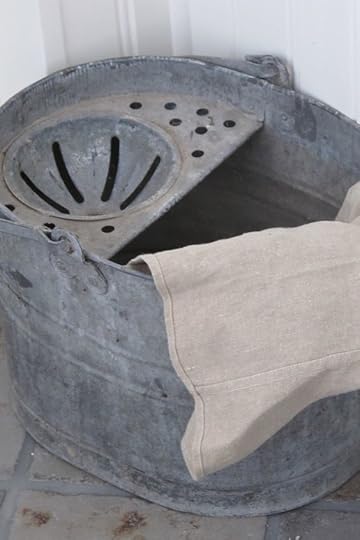
Whenever I'm having a bad day, I think about how hard my great-grandmother and other women of her generation had to work to keep their houses clean, and I stop crabbing. Attention: ladies and stay-at-home dads. We are SO spoiled.
Brooms were primitive, sometimes hand-made out of broomcorn (a variety of sorghum), straw, or the thinnest branches of a birch tree.

Cleaning a privy was an especially odious task. In Part V of Never Done I wrote:
Clara helped Sophie clean the two privies. This entailed sweeping them out, scrubbing around the two holes in each latrine, and replenishing the paper supply with whatever they could find: catalogs, nickel weeklies, calendars, almanacs, newspapers, even dog-eared dime novels. Finished up top, Clara tossed a cupful of lye powder down the holes.
“Smell better now, Missus,” Sophie would say, even when it didn’t.
Since most houses were heated by wood and lit by coal oil or kerosene lamps, layers of sooty grime built up over time, especially during winter months. Spring cleaning, now a ritual of the past, was imperative.
The plip, plip, plip of melting icicles signaled the beginning of what amounted to spring in Ophir Loop.
Inside the hotel, months of exposure to wood heat and coal oil lamps had left a greasy film on everything. Windows were thrown open and rugs and coverlets taken outside for a good beating. Curtains were washed, floors scrubbed, quilts boiled and stretched across tree stumps to dry. Every pillow and mattress was emptied, the ticking bleached, boiled, dried, and filled with clean hay or sheep shearing. The cans, cartons, baskets, and barrels that filled the cellar were shifted from one corner to another while the shelves were wiped down with vinegar water.
Vinegar water was also used to scrub floors, and scrubbing a floor wasn't a simple task when water wan't piped into the house. Most housewives had to haul water from a well or nearby stream in order to fill their wash pails. Mops were fashioned from heavy cord or strips of fabric torn from discarded sheets or clothing. One of the first labor-saving devices welcomed by the American housewife was the mop bucket with an attached wringer. This protected the woman's hands from the cramping and achy aftereffects of having to wring a mop out, over and over, by hand.

Whenever I'm having a bad day, I think about how hard my great-grandmother and other women of her generation had to work to keep their houses clean, and I stop crabbing. Attention: ladies and stay-at-home dads. We are SO spoiled.
Published on December 08, 2018 11:18
November 9, 2018
October Was the Cruelest Month
One hundred years have passed since the grim reaper variously called Spanish flu, Spanish Lady, French flu, or “La Grippe,” sickened one-third of the world’s inhabitants (roughly 500 million people). At its height the epidemic killed 759 Philadelphians during a single day in October. Worldwide casualty estimates vary, some being as high as 100 million people sickened by the disease, but there is widespread agreement that the 1918 flu caused more deaths than all military personnel killed by cannon, gunfire, bayonets, or poison gas during World War I. My paternal grandfather was one of the fatalities. He was living in Naturita, Colorado when in October of 1918 he, his pregnant wife and three young children came down with the deadly flu. Although my grandfather died his family survived, and two months later my grandmother gave birth to my father. That untimely sequence of events held a morbid fascination for me as a child, so much so I devoted part of my novel Never Done to the impact of Spanish flu on my family and the people of Colorado. While researching the 1918 flu, I was shocked by how easily it spread. Just touching a flu patient, even being in the same room was enough to catch it, making it a strain of flu more virulent than Europe’s bubonic plague which killed more people, but over a longer period of time. The plague that devastated Europe during the Middle Ages was spread by rodents and lice; whereas the Spanish flu was a virus. In 1918/19 an estimated 25 percent of the US population was infected with the baffling illness, and as many as 650,000 people died from it. The mountainous regions of Colorado were particularly hard hit due to the Western Slope’s large concentration of miners, men whose lungs were already compromised by the dust and bad air they breathed underground. Crowded conditions in city tenements also increased the likelihood of catching the disease. Symptoms of Spanish flu began much like today’s less virulent strains with headache, runny nose, or sore throat. Following in quick succession were fever, nausea, aching joints, and cough. The person infected became so fatigued he or she could barely stand. Dark, reddish spots or an overall redness appeared on some faces, and within hours the virus attacked the patient’s lungs in a brutal pneumonia. In the worst cases the patient’s lungs filled with a bloody froth and they bled from their nose, ears, or eyes. Some died less than a day after the first symptoms appeared. Others victims, like my grandfather, suffered for days or weeks. Worldwide, the death toll peaked during the fourth quarter of 1918. October, the same month my grandfather died, was particularly deadly in the United States. Philadelphia reported over 4,500 deaths during one week that month. When flu deaths mounted in October and doctors hadn’t found a cure, many Americans believed the disease signaled the end of mankind. Bend, though experiencing far fewer flu deaths than other parts of the country, shared in the panic when in mid-October city officials closed the schools and banned gatherings of more than 10 people. It was a ban that lasted until early December. Sporadic flu-related obituaries continued to appear in American newspapers during 1919, but by summer the disease had run its course. Since then, the world’s population has mushroomed; so has the number of people traveling across borders. If new viruses evolve, and they will, the chance of another global pandemic remains a threat to public health. In 1918 October may have been the cruelest month, but now it’s a good month to get your flu shot every year.
Published on November 09, 2018 14:40
October 11, 2018
To Market,To Market
to buy a fat pig, so the nursery rhyme tell us, and chances are to purchase a few more items if the day of the week is Thursday.
During the nineteenth and early twentieth century Thursday was usually the day American housewives did their food and sundry shopping. It was a good day to purchase what they needed for the weekend if guests were expected, leaving Friday free to clean house.
In Part IV of Never Done I wrote: "Every Thursday, Nettie and the other cooks and housekeepers in Philadelphia spent the day shopping, beginning at the grocer’s, then going to the butcher shop, the lamp oil dispensary, sometimes stopping at a tobacconist, hardware, or dry goods shop, or a florist if guests were expected."
Shopping in turn-of-the-century southern and western Colorado was a totally different experience, involving long trips to towns with a large enough population to support the luxury of specialty shops and general stores. "For Clara, going to market was a once-a-month experience, requiring half a day each way by horse and wagon. If she found what she needed when she got there, she bought it by the ten-pound sack or barrel."
Without stores, even a general store, women and men depended on nature to feed their families, raised what they needed, or bartered.
"Nature provided what couldn’t be purchased, changing what was on the supper table every season. In spring the newly sprouted pigweed was a good substitute for the spinach being served in Philadelphia, and Clara used the tender leaves and white roots of dandelions for salads. Fishing was especially good that time of year for trout that had spent the winter under ice.
When grass was growing knee-deep to a steer, it was prime time for gardening. The Stuart family had a large garden and fruit orchard. With seeds and starts from them, Clara planted a garden of her own."
"Phoebe’s family raised chickens and dairy cows, made delicious toffee, and traded what they had for what they didn’t. In autumn, the trees in their orchard were heavy with fruit. Albert shared the beef he butchered with his men, and Vincent traded some of it to the Stuarts for apples."
Just this week a few of my lady friends and I drove to Hood River, Oregon (famous for its fruit) to buy from a commercial orchard where we had our pick of dozens of varieties of apples and pears. We could have bought fruit that was almost as fresh in any of the many supermarkets, farmer's markets, or small stores right here in Central Oregon, but it was an excuse for an "outing." After loading up our cars with fruit we had a lovely lunch in the town of Hood River, then browsed through the shops downtown. We are SO spoiled.
a typical turn-of-the-century general store
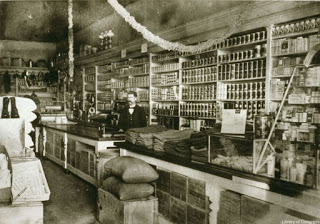
During the nineteenth and early twentieth century Thursday was usually the day American housewives did their food and sundry shopping. It was a good day to purchase what they needed for the weekend if guests were expected, leaving Friday free to clean house.
In Part IV of Never Done I wrote: "Every Thursday, Nettie and the other cooks and housekeepers in Philadelphia spent the day shopping, beginning at the grocer’s, then going to the butcher shop, the lamp oil dispensary, sometimes stopping at a tobacconist, hardware, or dry goods shop, or a florist if guests were expected."
Shopping in turn-of-the-century southern and western Colorado was a totally different experience, involving long trips to towns with a large enough population to support the luxury of specialty shops and general stores. "For Clara, going to market was a once-a-month experience, requiring half a day each way by horse and wagon. If she found what she needed when she got there, she bought it by the ten-pound sack or barrel."
Without stores, even a general store, women and men depended on nature to feed their families, raised what they needed, or bartered.
"Nature provided what couldn’t be purchased, changing what was on the supper table every season. In spring the newly sprouted pigweed was a good substitute for the spinach being served in Philadelphia, and Clara used the tender leaves and white roots of dandelions for salads. Fishing was especially good that time of year for trout that had spent the winter under ice.
When grass was growing knee-deep to a steer, it was prime time for gardening. The Stuart family had a large garden and fruit orchard. With seeds and starts from them, Clara planted a garden of her own."
"Phoebe’s family raised chickens and dairy cows, made delicious toffee, and traded what they had for what they didn’t. In autumn, the trees in their orchard were heavy with fruit. Albert shared the beef he butchered with his men, and Vincent traded some of it to the Stuarts for apples."
Just this week a few of my lady friends and I drove to Hood River, Oregon (famous for its fruit) to buy from a commercial orchard where we had our pick of dozens of varieties of apples and pears. We could have bought fruit that was almost as fresh in any of the many supermarkets, farmer's markets, or small stores right here in Central Oregon, but it was an excuse for an "outing." After loading up our cars with fruit we had a lovely lunch in the town of Hood River, then browsed through the shops downtown. We are SO spoiled.
a typical turn-of-the-century general store

Published on October 11, 2018 12:03
August 9, 2018
Make Do and Mend
Wednesday was the day women devoted to mending and sewing. A housewife may have noticed missing buttons or worn spots while washing clothes on Monday or ironing them on Tuesday, so it made sense to repair them on Wednesday. This included darning stockings. A darning egg or darning mushroom, tools shaped out of wood or another hard material, was inserted into the toe or heel of the sock to provide a platform for making the repair.
In Never Done, Clara’s sewing basket contained a darning egg along with “hooks and eyes, a pin cushion bristling with needles, four colors of heavy cotton thread, a skein of black wool yarn, a paper of straight pins, two sizes of scissors, and a thimble.”
Women also did most of their sewing on Wednesday. Prior to the first industrial revolution, clothing was made by hand, either by tailors or by women living at home. When women began working long days in factories they no longer had enough time or energy to sew clothing, therefore small clothing companies, pioneers of the clothing industry, began filling the need.
Employees of these companies still sewed by hand until the sewing machine was invented by an Englishman, Thomas Saint in 1790. Although this was before the power of electricity had been harnessed, cranking a wheel to make a needle go up and down was a huge time saver. Using a foot treadle was even more efficient.
Clara’s friend Phoebe “openly admired Clara’s shiny black sewing machine, one of the newer models that could be operated by a foot treadle as well as a hand-cranked wheel.”
In the remote parts of Colorado where Clara lived, fabric , yarn, and store-bought clothing were hard to find, making clothes and stockings worth more than the labor to mend them. Today’s clothing, most of it mass produced and cheaply made, is usually discarded if it needs mending; although a few people still mend seams and put in zippers.
treadle Singer and darning egg

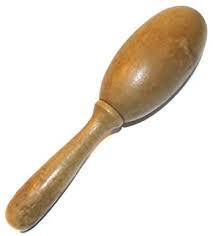
In Never Done, Clara’s sewing basket contained a darning egg along with “hooks and eyes, a pin cushion bristling with needles, four colors of heavy cotton thread, a skein of black wool yarn, a paper of straight pins, two sizes of scissors, and a thimble.”
Women also did most of their sewing on Wednesday. Prior to the first industrial revolution, clothing was made by hand, either by tailors or by women living at home. When women began working long days in factories they no longer had enough time or energy to sew clothing, therefore small clothing companies, pioneers of the clothing industry, began filling the need.
Employees of these companies still sewed by hand until the sewing machine was invented by an Englishman, Thomas Saint in 1790. Although this was before the power of electricity had been harnessed, cranking a wheel to make a needle go up and down was a huge time saver. Using a foot treadle was even more efficient.
Clara’s friend Phoebe “openly admired Clara’s shiny black sewing machine, one of the newer models that could be operated by a foot treadle as well as a hand-cranked wheel.”
In the remote parts of Colorado where Clara lived, fabric , yarn, and store-bought clothing were hard to find, making clothes and stockings worth more than the labor to mend them. Today’s clothing, most of it mass produced and cheaply made, is usually discarded if it needs mending; although a few people still mend seams and put in zippers.
treadle Singer and darning egg


Published on August 09, 2018 16:39



